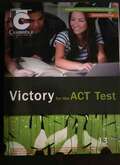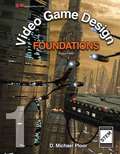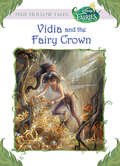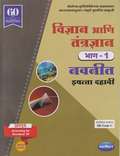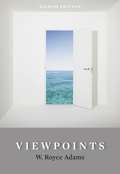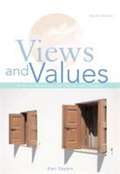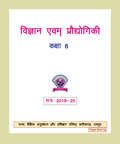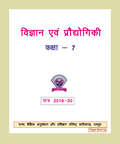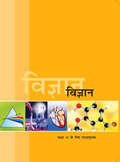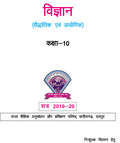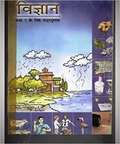- Table View
- List View
Vice & Virtue in Everyday Life: Introductory Readings in Ethics
by Christina Hoff Sommers Fred SommersA comprehensive and provocative collection of both classical and contemporary voices in perennial ethical debates, Vice and Virtue has established itself as one of the truly outstanding anthologies for Introduction to Ethics Courses.
Video Technology
by Against The ClockA Premiere project consists of a series of clips (audio, video,, and still images) assembled and precisely placed on a. Timeline. Premiere provides numerous, tools to make the editing process flow as easily as possible.
Vidia and the Fairy Crown (Disney Chapter Book (eBook) Ser.)
by Laura DriscollVidia can be nasty and selfish, but is she a thief? When she is falsely accused of stealing Queen Clarion’s crown, she begins an investigation that leads her on a wild-goose chase to the far corners of the Home Tree. Will Vidia be able to clear her name in time?
Vidnyan Ani Tantradnyan Bhag 1 Digest Class 10th Maharashtra Board - Guide: विज्ञान आणि तंत्रज्ञान भाग 1 डाइजेस्ट इयत्ता 10वी महाराष्ट्र बोर्ड - मार्गदर्शन
by Shri Navneetविज्ञान आणि तंत्रज्ञान भाग 1 इयत्ता 10वी चे पुस्तक नवनीत एज्युकेशन लिमिटेडने मराठी भाषेमध्ये प्रकाशित केलेले आहे, या पाठपुस्तकामधे दहा पाठ व त्यांची प्रश्नोत्तरे आणि बोर्डाची कृतिपत्रिका दिलेली आहे. प्रत्येक प्रकरणाच्या सुरुवातीला दिलेल्या 'महत्त्वाचे मुद्दे' यात, प्रकरणामध्ये असलेल्या सर्व अभ्यासघटकांचा समावेश आहे. काही ठिकाणी मुद्द्यांच्या स्वरूपात, तर काही ठिकाणी तक्त्यांच्या स्वरूपात माहितीची मांडणी करण्यात आली आहे. पाठ्यपुस्तकात आलेले 'सांगा पाहू' किंवा 'थोडे आठवा' या बाबी ‘महत्त्वाचे मुद्दे' यांत समाविष्ट करण्यात आल्या आहेत. यातील प्रश्नांची उत्तरे मिळाल्यावर किंवा कृती केल्यावर, त्यानंतर दिलेल्या मुद्द्यांचे आकलन होणे खूपच सोपे होईल, हा त्याचा मुख्य उद्देश आहे.
Viewpoints: Readings Worth Thinking and Writing About
by W. Royce AdamsSpark your interest in writing with VIEWPOINTS. This thematically organized reader offers diverse perspectives on various themes and issues, including social concerns, media, human behavior, cultural differences, and human rights. With opening chapters that include substantial writing and reading instruction and writing assignments both at the end of each reading and on the web, VIEWPOINTS takes writing and critical-thinking skills to the next level. This thoroughly revised Eighth Edition builds on the success of previous editions with twenty-four new readings, six new thought-provoking photographs, author biographies, and source information for every selection.
Views and Values: Diverse Readings on Universal Themes
by Kari SayersVIEWS AND VALUES is a thematic collection of 27 short fiction and non-fiction selections from international authors. Though the topics of the readings vary, the theme of "The Human Condition" threads through each of the selections to help students make connections in the different styles of writing.
Vignan class 8 - GSTB: વિજ્ઞાન ધોરણ 8
by Gujrat Rajya Pathyapustak Mandalઆ ધોરણ 8 ની વિજ્ઞાન વિષયનું પાઠ્યપુસ્તક છે.
Vigyan Evam Praudyogikee Batein class 8 - JCERT: व्यवसाय के तत्व ९वीं कक्षा - जेसीईआरटी
by Jharkhand Shaikshik Anusandhan Evam Prashikshan Parishad Ranchi"विज्ञान एवं प्रौद्योगिकी" कक्षा 8 की पुस्तक झारखंड शैक्षिक अनुसंधान एवं प्रशिक्षण परिषद द्वारा प्रकाशित की गई है। यह राष्ट्रीय पाठ्यचर्या रूपरेखा-2005 पर आधारित है और छात्रों को वैज्ञानिक दृष्टिकोण विकसित करने में मदद करती है। पुस्तक में 18 अध्याय हैं, जो विज्ञान की विविध अवधारणाओं को सरल भाषा और रोचक गतिविधियों के माध्यम से समझाते हैं। कोशिका की संरचना, धातु-अधातु, बल-दाब, ज्वाला, घर्षण, प्रकाश, और ध्वनि जैसे विषयों के साथ-साथ किशोरावस्था, फसल उत्पादन, और पर्यावरण संरक्षण पर भी विस्तृत जानकारी दी गई है। हर पाठ में व्यावहारिक गतिविधियाँ, परियोजना कार्य, और अभ्यास प्रश्न दिए गए हैं, जो छात्रों को विषय को गहराई से समझने में मदद करते हैं। इस पुस्तक की प्रमुख विशेषता यह है कि यह दैनिक जीवन के अनुभवों से विज्ञान को जोड़ते हुए छात्रों को प्रयोग आधारित सीखने के लिए प्रेरित करती है। शिक्षकों के लिए मार्गदर्शन और क्यु. आर कोड से डिजिटल सामग्री तक पहुँच को भी शामिल किया गया है। स्थानीय और राष्ट्रीय संदर्भों को ध्यान में रखते हुए तैयार यह पुस्तक छात्रों के नैतिक और वैज्ञानिक मूल्य भी विकसित करती है। विभिन्न वैज्ञानिक शब्दावली को सरल भाषा में प्रस्तुत किया गया है, जिससे छात्रों को कठिन अवधारणाएँ आसानी से समझने में मदद मिलती है। यह पुस्तक छात्रों को आत्म-विश्लेषण, निर्णय क्षमता, और पर्यावरण के प्रति जागरूकता विकसित करने में सहायक है। साथ ही, यह वैज्ञानिक खोजों और आविष्कारों की जानकारी प्रदान कर बच्चों को प्रेरित करती है। शिक्षक और छात्रों के सुझावों के आधार पर इसे और अधिक प्रभावी बनाने का प्रयास किया गया है। "अध्ययन ही जीवन की सर्वोत्तम तपस्या है" — इस आदर्श वाक्य के साथ यह पुस्तक छात्रों को निरंतर सीखने के लिए प्रोत्साहित करती है।
Vigyan Evam Praudyogiki class 6 - S.C.E.R.T. Raipur - Chhattisgarh Board: विज्ञान एवं प्रौद्योगिकी कक्षा 6 - एस.सी.ई.आर.टी. रायपुर - छत्तीसगढ़ बोर्ड
by Raipur C. G. Rajya Shaikshik Anusandhan Aur Prashikshan Parishadविज्ञान एवं प्रौद्योगिकी पाठ्यपुस्तक कक्षा 6 वी का राज्य शैक्षिक अनुसंधान और प्रशिक्षण परिषद् छत्तीसगढ़ रायपुर ने हिंदी भाषा में प्रकाशित किया गया है, इस पाठ्यपुस्तक में सोलह अध्याय दिये गए है। पाठ्यपुस्तक में हमारी पृथ्वी और सौर परिवार के बारे में बताया है, पर्यावरण के घटक, पदार्थ की प्रकृति और पदार्थों का पृथक्करण, हमारे चारों और होनेवाले बदल और परिवर्तन आदि के बारे में समजाया गया है। मापन, सजीवों के लक्षण एवं वर्गीकरण, सजीवों की संरचना तथा उनके कार्य, गति-बल तथा दाब इनके बारे में पाठ्यपुस्तक में स्पष्टीकरण दिया गया है। इस पाठ्यपुस्तक में विज्ञान और गणित के क्षेत्र में विश्व को गौरवशाली योगदान प्रदान करने वाले कुछ महान भारतीय वैज्ञानिकों तथा गणितज्ञों के विषय में जानकारी भी दी गई है।
Vigyan Evam Praudyogiki class 7 - S.C.E.R.T. Raipur - Chhattisgarh Board: विज्ञान एवं प्रोद्योगिकी कक्षा 7 - एस.सी.ई.आर.टी. रायपुर - छत्तीसगढ़ बोर्ड
by Raipur C. G. Rajya Shaikshik Anusandhan Aur Prashikshan Parishadविज्ञान एवं प्रोद्योगिकी पाठ्यपुस्तक कक्षा 7 वीं का राज्य शैक्षिक अनुसंधान और प्रशिक्षण परिषद् छत्तीसगढ़ रायपुर ने हिंदी भाषा में प्रकाशित किया गया है, इस पाठ्यपुस्तक में इक्कीस अध्याय दिये गए है। पाठ्यपुस्तक में हमारी पृथ्वी और पृथ्वी पर जीवन, जल, पदार्थ की संरचना और अम्ल क्षारक एवं लवण, मापन, सजीव जगत में संगठन, ऊष्मा तथा ताप और ऊष्मा का संचरण आदि के बारे में समजाया गया है। सजीवों में पोषण, सजीवों में श्वसन, रेशों से वस्त्र, प्रकाश का परावर्तन, सजीवों में परिवहन, उत्सर्जन, सजीवों में नियंत्रण एव समन्वय के बारे में पाठ्यपुस्तक में जानकारी दि है। स्थिर विद्युत, कंकाल जोड़ एवं पेशियाँ, मिट्टी, सजीवों में प्रजनन और विद्युत धारा ओर इसके प्रभाव आदि पुस्तक में स्पष्टीकरण दिया गया है। इस पाठ्यपुस्तक में वैज्ञानिकों के चिंतन तथा वैज्ञानिक पद्धति से मानव जीवन में आए क्रांतीकारी परिवर्तनों का अध्ययन करेंगे।
Vigyan Evam Praudyogiki class 8 - S.C.E.R.T. Raipur - Chhattisgarh Board: विज्ञान एवं प्रौद्योगिकी कक्षा 8 - एस.सी.ई.आर.टी. रायपुर - छत्तीसगढ़ बोर्ड
by Raipur C. G. Rajya Shaikshik Anusandhan Aur Prashikshan Parishadविज्ञान एवं प्रौद्योगिकी पाठ्यपुस्तक कक्षा 8वी का राज्य शैक्षिक अनुसंधान और प्रशिक्षण परिषद् छत्तीसगढ़ रायपुर ने हिंदी भाषा में प्रकाशित किया गया है, इस पाठ्यपुस्तक में सत्रह अध्याय दिये गए है। पाठ्यपुस्तक में आकाश दर्शन (आकाश में क्या-क्या है?), संश्लेषित रेशे और प्लास्टिक (संश्लेषित रेशे क्या है), वायुमण्डल, रासायनिक अभिक्रियाएँ - कब और कैसी-कैसी होती है, धातुएँ और अधातुएँ, कार्बन, शरीर की रचनात्मक एवं कार्यात्मक इकाई-कोशिका, सूक्ष्मजीव- एक अद्भुत संसार, प्रकाश का अपवर्तन आदी के बारे में बताया गया है। ध्वनि, विद्युत धारा के रासायनिक प्रभाव, ऊर्जा के स्रोत, खाद्य उत्पादन एवं प्रबंधन, कितना भोजन, कैसा भोजन और कुछ सामान्य रोग इनके बारे में पाठ्यपुस्तक में स्पष्टीकरण दिया गया है। इस पाठ्यपुस्तक में विज्ञान और गणित के क्षेत्र में विश्व को गौरवशाली योगदान प्रदान करने वाले कुछ महान भारतीय वैज्ञानिकों तथा गणितज्ञों के विषय में जानकारी भी दी गई है।
Vigyan Ki Batein class 7 - JCERT: विज्ञान की बातें ७वीं कक्षा - जेसीईआरटी
by Jharkhand Shaikshik Anusandhan Evam Prashikshan Parishad Ranchiइस पाठ्यपुस्तक "विज्ञान की बातें" का मुख्य उद्देश्य सातवीं कक्षा के विद्यार्थियों को विज्ञान की अवधारणाओं से सरल भाषा में परिचित कराना है। यह पुस्तक विभिन्न वैज्ञानिक सिद्धांतों, प्रक्रियाओं और अवधारणाओं को समझाने के लिए परियोजना कार्यों, क्रियाकलापों, और चित्रों का उपयोग करती है। पुस्तक "विज्ञान की बातें" विज्ञान की विभिन्न अवधारणाओं को बच्चों के दैनिक जीवन से जोड़ते हुए उनकी समझ विकसित करती है। इसमें पौधों में पोषण से लेकर जंतुओं में पाचन, जल और अपशिष्ट जल प्रबंधन, कीटभक्षी पौधों, प्रकाश संश्लेषण, और विद्युत धारा के प्रभाव जैसी जटिल अवधारणाओं को सरल और बोधगम्य भाषा में प्रस्तुत किया गया है। इसमें दिए गए क्रियाकलाप और परियोजनाएं छात्रों को अपने पर्यावरण से जोड़ने में मदद करती हैं, जैसे पेड़-पौधों के संरक्षण और जल प्रबंधन का महत्व। इसके अलावा, बच्चों में वैज्ञानिक दृष्टिकोण उत्पन्न करने और उन्हें निर्णय लेने की क्षमता विकसित करने के लिए अनेक अभ्यास प्रश्न, सारणी, और परियोजना कार्य दिए गए हैं। पुस्तक में सीखने के प्रतिफल और QR कोड के माध्यम से डिजिटल सामग्री तक पहुंचने की सुविधा दी गई है, जिससे छात्रों की समझ और बेहतर होती है। यह पुस्तक झारखंड राज्य के विशेष संदर्भों के साथ वैज्ञानिक तथ्यों को प्रस्तुत करती है।
Vigyan Saiddhantik Evam Prayogik class 9 - S.C.E.R.T. Raipur - Chhattisgarh Board: विज्ञान सैद्धांतिक एवं प्रायोगिक कक्षा 9 - एस.सी.ई.आर.टी. रायपुर - छत्तीसगढ़ बोर्ड
by Raipur C. G. Rajya Shaikshik Anusandhan Aur Prashikshan Parishadविज्ञान सैद्धांतिक एवं प्रायोगिक पाठ्यपुस्तक कक्षा 9वी का राज्य शैक्षिक अनुसंधान और प्रशिक्षण परिषद् छत्तीसगढ़ रायपुर ने हिंदी भाषा में प्रकाशित किया गया है, इस पाठ्यपुस्तक में विज्ञान की शिक्षा इस बात पर भी निर्भर करती है कि विषयवस्तु को विद्यार्थियों के अनुभवों व परिवेश से कैसे जोड़ें, जिससे सीखना स्थायी हो सकें। विषयवस्तु को समझने के लिए विभिन्न तथ्यों, नियमों, सिद्धांतों और परिघटनाओं का उपयोग किया गया है, पाठ्यपुस्तक में एन.सी.एफ. में निहित सभी वैधताओं (संज्ञानात्मक, विषयवस्तु, प्रक्रिया, ऐतिहासिक, पर्यावरणीय एवं नैतिक) का भी ध्यान रखा गया है। पाठ्यपुस्तक लेखन का कार्य शिक्षकों, शिक्षक प्रशिक्षकों तथा सहयोगी संस्थाओं के साथियों द्वारा किया गया है।
Vigyan aur Praudyogiki bhag-2 class 10 - Maharashtra Board: विज्ञान और प्रौद्योगिकी भाग-२ १०वीं कक्षा - महाराष्ट्र बोर्ड
by Maharashtra Rajya Pathyapustak Nirmiti Va Abhysakram Sanshodhan Mandal Pune‘विज्ञान और प्रौद्योगिकी – भाग 2’ दसवीं कक्षा की पाठ्यपुस्तक है, जिसमें आनुवांशिकता, उत्क्रांति, कोशिका विज्ञान, जैव प्रौद्योगिकी, पर्यावरण संरक्षण, ऊर्जा स्रोत, सामाजिक स्वास्थ्य और आपदा प्रबंधन जैसे महत्वपूर्ण विषयों को शामिल किया गया है। पुस्तक का उद्देश्य विद्यार्थियों में वैज्ञानिक दृष्टिकोण विकसित करना, प्रयोगात्मक गतिविधियों के माध्यम से विज्ञान को समझना और उसके व्यावहारिक उपयोगों से अवगत कराना है। इसमें आनुवंशिक परिवर्तन, सजीवों की जीवन प्रक्रियाएँ, पर्यावरणीय चुनौतियाँ, हरित ऊर्जा और जैविक विविधता पर विशेष ध्यान दिया गया है। विभिन्न अध्यायों में वैज्ञानिक अवधारणाओं को सरल भाषा में समझाया गया है और प्रश्नोत्तरी, प्रयोग तथा गतिविधियों को शामिल किया गया है ताकि छात्र न केवल पढ़ें बल्कि उसे व्यवहारिक रूप से समझ सकें। यह पुस्तक विद्यार्थियों को विज्ञान के प्रति रुचि बढ़ाने, तार्किक सोच विकसित करने और उनके बौद्धिक विकास में सहायक होती है।
Vigyan class 10 - Himachal Pradesh Board: विज्ञान कक्षा १० - हिमाचल प्रदेश बोर्ड
by Himachal Pradesh Board of School Education - Dharamshalaहिमाचल प्रदेश स्कूल शिक्षा बोर्ड, धर्मशाला द्वारा प्रकाशित कक्षा 10 के लिए "विज्ञान" का डिजिटल संस्करण, 2013 से 2022 तक की विभिन्न संस्करणों और पुनर्मुद्रितियों को शामिल करता है। इसका सारांश पाठ्यक्रम और शिक्षण प्रक्रिया के माध्यम से शिक्षकों और छात्रों के बीच एक सेतु के रूप में काम करता है। यह मूल्यांकन, संबोधन, और अच्छी तरह से प्रस्तुत सामग्री की महत्वता पर जोर देता है। रासायनिक अभिक्रियाएँ एवं समीकरण, अम्ल, क्षारक एवं लवण, धातु एवं अधातु, कार्बन एवं उसके यौगिक, तत्वों का आवर्त वर्गीकरण, जैव प्रक्रम, नियंत्रण एवं समन्वय, जीव जनन कैसे करते हैं, आनुवंशिकता एवं जैव विकास, प्रकाश-परावर्तन तथा अपवर्तन, मानव नेत्र तथा रंगबिरंगा संसार, विद्युत, विद्युत धारा के चुंबकीय प्रभाव, ऊर्जा के स्रोत, हमारा पर्यावरण और प्राकृतिक संसाधनों का संपोषित प्रबंधन। इसमें मानक पाठ्यक्रम के विषय शामिल हैं जैसे रासायनिक प्रतिक्रियाएं और समीकरण, धातु और अधातु, अम्ल, क्षार और लवण, कार्बन, आवर्त सारणी, जीवन प्रक्रियाएं, प्रजनन, आनुवंशिकता, प्रकाश, बिजली, मानव आंख, ऊर्जा, चुंबकत्व, पर्यावरण और संसाधन प्रबंधन। सीखने को आसान बनाने के लिए, किताबें चित्रों से सुसज्जित हैं जो छात्रों को स्पष्ट विचार बताती हैं। इसी तरह, पुस्तक में दिए गए उदाहरण अच्छी तरह से वर्णित हैं और उत्पन्न होने वाले किसी भी भ्रम को दूर करने में मदद करते हैं। यह पुस्तक हल किए गए और अनसुलझे प्रश्नों के साथ भी आती है ताकि छात्र स्वयं का परीक्षण कर सकें और अपने कौशल में सुधार कर सकें।
Vigyan class 10 - NCERT - 23: विज्ञान १०वीं कक्षा - एनसीईआरटी - २३
by Rashtriy Shaikshik Anusandhan Aur Prashikshan Parishadविज्ञान कक्षा 10वीं का राष्ट्रीय शैक्षिक अनुसंधान और प्रशिक्षण परिषद् ने पुस्तक हिंदी भाषा में प्रकाशित किया गया है, विज्ञान की इस पाठ्यपुस्तक में, जहाँ कहीं संभव हुआ है, प्रासंगिक सामाजिक सरोकारों को शामिल करने का एक सजग एवं सार्थक प्रयास किया गया है। विशेष आवश्यकता वाले समूह, लिंग भेदभाव, ऊर्जा और पर्यावरण संबंधी मुद्दों को इस पुस्तक में सहजता से समाहित किया गया है। इस पुस्तक के माध्यम से विद्यार्थियों को प्रबंधन संबंधित कुछ सरोकारों (उदाहरणार्थ, संपोषणीय विकास) पर परिचर्चा करने की प्रेरणा भी मिलेगी ताकि वे इनसे संबंधित सभी तथ्यों का वैज्ञानिक विश्लेषण करने के पश्चात स्वयं निर्णय ले सकें। इस पुस्तक की कुछ विशेषताएँ इसके प्रभाव को एक विस्तृत आयाम देती हैं। प्रत्येक अध्याय की भूमिका दैनिक जीवन से संबंधित उदाहरणों के साथ दी गई है तथा यथासंभव रूप से विद्यार्थियों द्वारा किए जा सकने वाले क्रियाकलापों को भी समाहित किया गया है।
Vigyan class 10 - S.C.E.R.T. Raipur - Chhattisgarh Board: विज्ञान कक्षा 10 - एस.सी.ई.आर.टी. रायपुर - छत्तीसगढ़ बोर्ड.
by Raipur C. G. Rajya Shaikshik Anusandhan Aur Prashikshan Parishadविज्ञान कक्षा 10 वी का राज्य शैक्षिक अनुसंधान और प्रशिक्षण परिषद् छत्तीसगढ़ रायपुर ने पुस्तक हिंदी भाषा में प्रकाशित किया गया है, इस पाठपुस्तक में विज्ञान संबंधित जानकारियों को विवेकपूर्ण तरीकों से प्राप्त करना, प्रयोगों से जुड़े और सिद्धान्तों को परखने के लिए अग्रसर किया गया है। कक्षा 10 में विज्ञान विषय के अन्तर्गत गणितीय आँकड़े इकट्ठे करने, आंकड़ों का विश्लेषण करने, उनकी तुलना करने और निष्कर्ष निकालने इन सभी प्रत्यक्ष अनुभव का इस पाठपुस्तक में समावेश किया गया है।
Vigyan class 6 - NCERT - 23: विज्ञान ६वीं कक्षा - एनसीईआरटी - २३
by Rashtriy Shaikshik Anusandhan Aur Prashikshan Parishadविज्ञान ६वीं कक्षा इस पाठ्यपुस्तक में भोजन के घटक, वस्तुओं के समूह बनाना, पदार्थों का पृथक्करण, पौधों को जानिए, शरीर में गति, सजीव- विशेषताएँ एवं आवास, गति एवं दूरियों का मापन, प्रकाश-छायाएँ एवं परावर्तन, विद्युत् तथा परिपथ, चुंबकों द्वारा मनोरंजन और हमारे चारों ओर वायु के बारे में एक संक्षिप्त विचार मिलता है। 6 वीं कक्षा के छात्रों के लिए बनाया गया, इस पुस्तक में उन सभी विषयों को शामिल किया गया है, जिन्हें केंद्रीय माध्यमिक शिक्षा बोर्ड द्वारा उल्लिखित किया गया है।
Vigyan class 7 - GSTB: વિજ્ઞાન ધોરણ ૭ - જીએસટીબી
by Gstbઆ પાઠ્ય પુસ્તકનો અનુવાદ તથા તેની સમીક્ષા નિષ્ણાત પ્રાધ્યાપકો અને શિક્ષકો પાસે કરાવવામાં આવ્યા છે અને સમીક્ષકોનાં સૂચનો અનુસાર હરતપ્રતમાં યોગ્ય સુધારા - વધારા કર્યા પછી આ પાઠયપુસ્તક પ્રસિદ્ધ કરવામાં આવેલ છે. જેમાં ૧૮ પ્રકરણ આપેલ છે.
Vigyan class 7 - NCERT - 23: विज्ञान ७वीं कक्षा - एनसीईआरटी - २३
by Rashtriy Shaikshik Anusandhan Aur Prashikshan Parishadविज्ञान कक्षा 7 के लिए यह पाठ्यपुस्तक युवा दिमागों को स्पष्ट समझ रखने में मदद करेगी कि पोषक तत्व क्या हैं और वे पौधों और जानवरों में क्यों महत्वपूर्ण हैं। छात्रों को एसिड, लवण और क्षार के बारे में एक संक्षिप्त विचार मिलता है और यह भी कि रासायनिक प्रतिक्रियाएं कैसे होती हैं। 7 वीं कक्षा के छात्रों के लिए बनाया गया, इस पुस्तक में उन सभी विषयों को शामिल किया गया है, जिन्हें केंद्रीय माध्यमिक शिक्षा बोर्ड द्वारा उल्लिखित किया गया है।
Vigyan class 7 - NCERT: विज्ञान कक्षा 7 - एनसीईआरटी
by Rashtriy Shaikshik Anusandhan Aur Prashikshan Parishadविज्ञान कक्षा 7 के लिए यह पाठ्यपुस्तक युवा दिमागों को स्पष्ट समझ रखने में मदद करेगी कि पोषक तत्व क्या हैं और वे पौधों और जानवरों में क्यों महत्वपूर्ण हैं। छात्रों को एसिड, लवण और क्षार के बारे में एक संक्षिप्त विचार मिलता है और यह भी कि रासायनिक प्रतिक्रियाएं कैसे होती हैं। 7 वीं कक्षा के छात्रों के लिए बनाया गया, इस पुस्तक में उन सभी विषयों को शामिल किया गया है, जिन्हें केंद्रीय माध्यमिक शिक्षा बोर्ड द्वारा उल्लिखित किया गया है।


